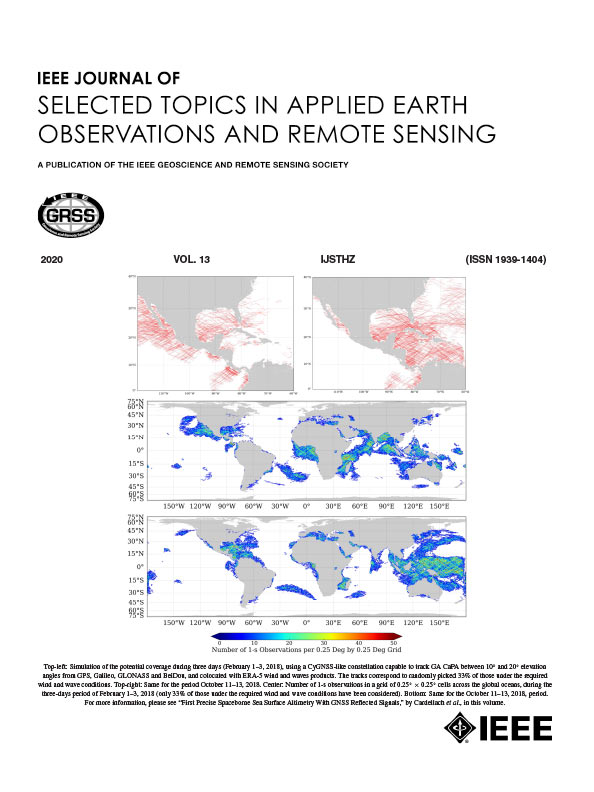中国GF3B和SVN2-01/02卫星立体SAR三维地面控制点自动提取
IF 5.3
2区 地球科学
Q1 ENGINEERING, ELECTRICAL & ELECTRONIC
IEEE Journal of Selected Topics in Applied Earth Observations and Remote Sensing
Pub Date : 2025-08-25
DOI:10.1109/JSTARS.2025.3602096
引用次数: 0
摘要
从星载合成孔径雷达(SAR)中提取地面控制点(gcp)是一种快速、非接触、全球可用的地理参考技术。近年来,中国在SAR卫星的部署和应用方面取得了重大进展。然而,高精度gcp的自动推导仍然具有挑战性,主要是由于两个关键因素:1)需要高精度的SAR几何观测校准;2)候选gcp (cgcp)在不同视角获取的SAR图像中自动检测和匹配。本文提出了一种改进的GCP提取算法框架,并展示了中国SAR卫星的应用潜力。主要改进如下。1)在几何定标过程中加入波束相关偏差,以获得更高的测距精度。2)设计了一种利用形状特征对CGCP进行鲁棒识别的CGCP检测器,无需依赖任何外部数据。3)提出了一种结合预处理、特征描述和转换搜索策略的综合匹配方案,实现了cgcp的有效配对。利用来自中国高分3b和Superview neo - 201 /02卫星的SAR图像,使用澳大利亚的开放接入角反射器阵列进行几何校准。在苏州地区进行了GCP提取实验,自动提取了7477个GCP,均方根误差优于1 m。本文章由计算机程序翻译,如有差异,请以英文原文为准。
Automatic Extraction of 3-D Ground Control Points Using Stereo SAR from China’s GF3B and SVN2-01/02
The extraction of ground control points (GCPs) from spaceborne synthetic aperture radar (SAR) is an effective technique for rapid, contactless, and globally available georeferencing. In recent years, China has made significant progress in the deployment and application of SAR satellites. However, the automatic derivation of high-precision GCPs remains challenging, primarily due to two key factors: 1) the need for high-accuracy calibration of SAR geometric observations and 2) the automatic detection and matching of candidate GCPs (CGCPs) across SAR images acquired from different look angles. This article proposed an improved algorithm framework for GCP extraction and demonstrated the application potential of China’s SAR satellites. The main improvements are as follows. 1) Beam-dependent biases are incorporated into the geometric calibration process to achieve higher ranging accuracy. 2) A CGCP detector is designed that leverages shape characteristics to robustly identify CGCPs without relying on any external data. 3) An integrated matching scheme is proposed, which combines preprocessing, feature description, and transformation-search strategies to enable effective pairing of CGCPs. SAR imagery from China’s Gaofen-3B and Superview Neo-2 01/02 satellites is utilized, and geometric calibration is performed using the open-access corner reflector array in Australia. GCP extraction experiments are conducted in the Suzhou area, with 7477 GCPs automatically extracted and a root mean square error better than 1 m.
求助全文
通过发布文献求助,成功后即可免费获取论文全文。
去求助
来源期刊
CiteScore
9.30
自引率
10.90%
发文量
563
审稿时长
4.7 months
期刊介绍:
The IEEE Journal of Selected Topics in Applied Earth Observations and Remote Sensing addresses the growing field of applications in Earth observations and remote sensing, and also provides a venue for the rapidly expanding special issues that are being sponsored by the IEEE Geosciences and Remote Sensing Society. The journal draws upon the experience of the highly successful “IEEE Transactions on Geoscience and Remote Sensing” and provide a complementary medium for the wide range of topics in applied earth observations. The ‘Applications’ areas encompasses the societal benefit areas of the Global Earth Observations Systems of Systems (GEOSS) program. Through deliberations over two years, ministers from 50 countries agreed to identify nine areas where Earth observation could positively impact the quality of life and health of their respective countries. Some of these are areas not traditionally addressed in the IEEE context. These include biodiversity, health and climate. Yet it is the skill sets of IEEE members, in areas such as observations, communications, computers, signal processing, standards and ocean engineering, that form the technical underpinnings of GEOSS. Thus, the Journal attracts a broad range of interests that serves both present members in new ways and expands the IEEE visibility into new areas.

 求助内容:
求助内容: 应助结果提醒方式:
应助结果提醒方式:


